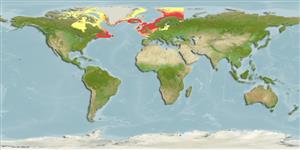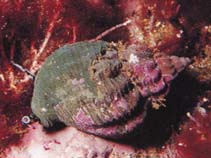Advertisement
Buccinum undatum Linnaeus, 1758
Waved whelk| Native range | All suitable habitat | Point map | Year 2050 |

|
| This map was computer-generated and has not yet been reviewed. |
| Buccinum undatum AquaMaps Data sources: GBIF OBIS |
Isle of Man country information
Common names:
[No common name]
Occurrence: native
Salinity: marine
Abundance: | Ref:
Importance: | Ref:
Aquaculture: never/rarely | Ref:
Regulations: no regulations | Ref:
Uses: no uses
Comments: Known off Douglas, Isle of Man.
National Checklist:
Country Information: https://www.cia.gov/library/publications/resources/the-world-factbook/geos/im.html
National Fisheries Authority:
Occurrences: Occurrences Point map
Main Ref: Kideys, A.E., 1998
National Database:
Occurrence: native
Salinity: marine
Abundance: | Ref:
Importance: | Ref:
Aquaculture: never/rarely | Ref:
Regulations: no regulations | Ref:
Uses: no uses
Comments: Known off Douglas, Isle of Man.
National Checklist:
Country Information: https://www.cia.gov/library/publications/resources/the-world-factbook/geos/im.html
National Fisheries Authority:
Occurrences: Occurrences Point map
Main Ref: Kideys, A.E., 1998
National Database:
Common names from other countries
Classification / Names Tên thường gặp | Các synonym ( Các tên trùng) | Catalog of Fishes (gen., sp.) | ITIS | CoL | WoRMS
Environment: milieu / climate zone / depth range / distribution range Sinh thái học
; Mức độ sâu 0 - 600 m (Tài liệu tham khảo 78657). Temperate, preferred 11°C (Tài liệu tham khảo 107945); 85°N - 36°N, 110°W - 45°E
Distribution Các nước | Các khu vực của FAO | Các hệ sinh thái | Những lần xuất hiện | Những chỉ dẫn
Arctic, Northern Atlantic and the Mediterranean: Canadian Arctic Archipelago and the Atlantic Ocean. Temperate to polar climates.
Length at first maturity / Bộ gần gũi / Weight / Age
Maturity: Lm ?, range 5 - 7.2 cm Max length : 10.2 cm SHL con đực/không giới tính; (Tài liệu tham khảo 360); common length : 5.1 cm SHL con đực/không giới tính; (Tài liệu tham khảo 360)
Short description Hình thái học
Shell: not very thick, solid, conical spire, generally high, sometimes rather flattened spires, very convex whorls and markedly impressed suture; ovoidal aperture, outer lip is not thickened or toothed, lacks inner folds; columellar lip has a fairly striking callus, partly adheres to the ventral surface of the body whorl; sculpture has almost equidistant spiral grooves and quite big axial ribs that tend to fade at the edge of the body whorl and are generally sinous; yellowish white or light hazel in color; periostracum is light chestnut in color and not very resistant; operculum is horny, smaller than the aperture, has a central nucleus. Body: large foot, whole body cream with blackish patches; head has a pair of tentacles with an eye at the base of each, long proboscis; well-developed siphon; radula is rachnioglossan.
Maximum depth from Ref. 106864. Common in the continental shelf (Ref. 106864). Common in the subtidal to 200 m depth in the northern Atlantic (Ref. 78657). Usually found on hard bottoms (Ref. 95730), as well as soft bottoms from 5 to 600 m (Ref. 106864). Also found to occur in areas with sludge (Ref. 96352). Relatively sedentary (Ref. 106864). It is a necrophagous, scavenger species (Ref. 96498). Feeds on polychaetes, mollusks, echinoderms and other smaller crustaceans (Ref. 106864). Also found in mud, sand, gravel and rocks (Ref. 78654).
Life cycle and mating behavior Chín muồi sinh dục | Sự tái sinh sản | Đẻ trứng | Eggs | Sự sinh sản | Larvae
Females gather in groups to deposit eggs in a communal mass of egg capsules where veligers develop and metamorphose inside and later hatch out as young individuals (Ref. 360).
Main reference
Các tài liệu tham khảo | Người điều phối | Người cộng tác
Harms, J. 1993. (Tài liệu tham khảo 2711)
IUCN Red List Status
(Tài liệu tham khảo 130435: Version 2024-2)
CITES status (Tài liệu tham khảo 108899)
Not Evaluated
CMS (Tài liệu tham khảo 116361)
Not Evaluated
Human uses
Các nghề cá: Tính thương mại
FAO - Các nghề cá: landings, species profile | FishSource | Biển chung quanh ta
Các công cụ
Thêm thông tin
Các nước
Các khu vực của FAO
Các hệ sinh thái
Những lần xuất hiện
Những chỉ dẫn
Stocks
Sinh thái học
Thành phần thức ăn
Các loại thức ăn
Các khu vực của FAO
Các hệ sinh thái
Những lần xuất hiện
Những chỉ dẫn
Stocks
Sinh thái học
Thành phần thức ăn
Các loại thức ăn
Tên thường gặp
Các synonym ( Các tên trùng)
Các động vật ăn mồi
Sự tái sinh sản
Chín muồi sinh dục
Đẻ trứng
Sự sinh sản
Eggs
Egg development
Các synonym ( Các tên trùng)
Các động vật ăn mồi
Sự tái sinh sản
Chín muồi sinh dục
Đẻ trứng
Sự sinh sản
Eggs
Egg development
Các nguồn internet
BHL | BOLD Systems | CISTI | DiscoverLife | FAO(Các nghề cá: species profile; publication : search) | GenBank (genome, nucleotide) | GloBI | Gomexsi | Google Books | Google Scholar | Google | PubMed | Cây Đời sống | Wikipedia (Go, tìm) | Tạp chí Zoological Record
Estimates based on models
Preferred temperature
(Ref. 115969): 7 - 11.8, mean 9.8 (based on 337 cells).
Thích nghi nhanh
(Tài liệu tham khảo 69278)
Trung bình, thời gian nhân đôi của chủng quần tối thiểu là 1.4 - 4.4 năm (K=0.2-0.22; tm=7.5).
Prior r = 0.57, 95% CL = 0.37 - 0.85, Based on 1 data-limited stock assessment.




